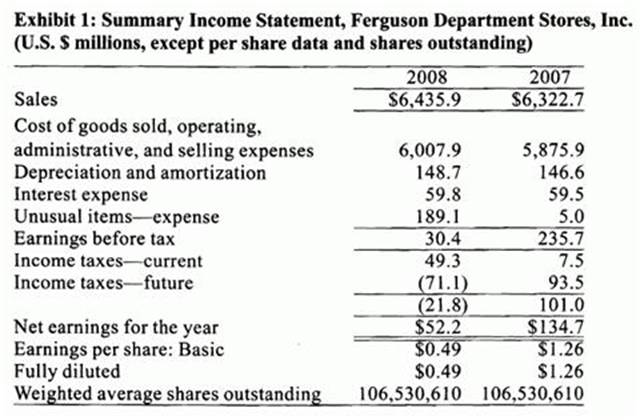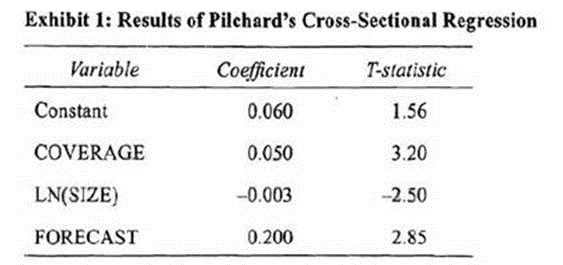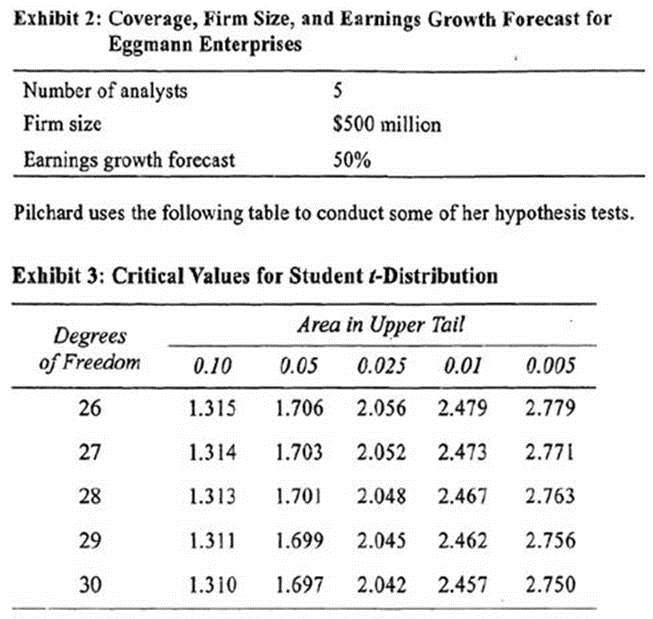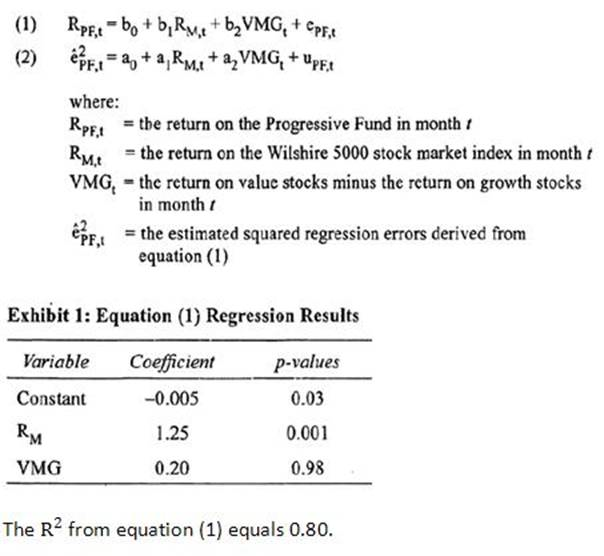CFA Institute CFA Level II Chartered Financial Analyst CFA-Level-II Exam Practice Test
Valentine notes that a share of Trailblazer's stock is currently priced at $32. Moreover, she expects the dividend for next year to be $1.47 and forecasts that the price of one share of Trailblazer stock at the end of the year wilt be $35.
In her report, Valentine makes the following statements about Trailblazer dividends:
Statement 1: Trailblazer is expected to pay a dividend next year and will continue to do so for the foreseeable future.
Statement 2: The required rate of return for Trailblazer stock will likely exceed the growth rate of its dividends.
Statement 3: Trailblazer is in a mature sector of its industry, and accordingly,
I expect dividends to decline to a constant rate of 4% indefinitely.
In speaking to a colleague at her firm, Valentine makes the following additional statements after her report is released:
Statement 4: Trailblazer has a 10-year history of paying regular quarterly dividends.
Statement 5: Over a recent 10-year period, Trailblazer has experienced one 3-year period of consecutive losses and another period of two annual losses in a row but has been extremely profitable in the remaining five years.
Valentine is concerned about the theoretical validity of using the APT to obtain an estimate of the required rate of return on equity. She decides to attend a conference dealing specifically with estimation techniques that analysts can employ. At one of the conference seminars, the following points are made:
Statement 6: The APT is a better approach than the CAPM because even though the factor risk premiums are difficult to estimate, the CAPM is more problematic because it relies on a single market risk premium estimate, which in turn leads to greater input uncertainty.
Statement 7: Model uncertainty is a problem with the APT but not with the CAPM.
Valentine is also analyzing the stock of Farwell, Inc. Farwell shares are currently trading at $48 based on current earnings of $4 and a current dividend of $2.60. Dividends are expected to grow at 5% per year indefinitely. The risk-free rate is 3.5%, the market risk premium is 4.5%, and Farwell's beta is estimated to be 1.2.
Do Statements 4 and 5 support the decision by Valentine to use a dividend discount model?
Answer : B
For a DDM ro be appropriate for valuation purposes, dividends must be a reasonably good measure of the cash flow of a firm. Dividends are appropriate for measuring cash flow when a company has a history of dividend payments, when the dividend policy is clear and related to the firm's earnings, and when the perspective is that of a minority shareholder. The two statements relate to the history of dividends and rhe relationship between dividends and earnings. Statement 4 supports the use of dividends since the history of paying dividends is fairly long and consistent. Statement 5 suggests that the relationship between dividends and earnings is not very strong since the company continues to pay regular dividends regardless of whether losses are incurred or profits are earned. (Study Session 11, LOS 40.b)
Matthew Emery, CFA, is responsible for analyzing companies in the retail industry. He is currently reviewing the status of Ferguson Department Stores, Inc. (FDS). FDS has recently gone through extensive restructuring in the wake of a slowdown in the economy that has made retailing particularly challenging. As part of his analysis, Emery has gathered information from a number of sources.
Ferguson Department Stores, Inc.
FDS went public in 1969 following a major acquisition, and the Ferguson name quickly became one of the most recognized in retailing. Ferguson had been successful through most of its first 30 years in business and has prided itself on being the one-stop shopping destination for consumers living on the West Coast of the United States. Recently, FDS began to experience both top and bottom line difficulties due to increased competition from specialty retailers who could operate more efficiently and offer a wider range of products in a focused retailing sector. When the company's main bank reduced FDS's line of credit, a serious working capital crisis ensued, and the company was forced to issue additional equity in an effort to overcome the problem. FDS has a cost of capital of 10% and a required rate of return on equity of 12%. Dividends are growing at a rate of 8%, but the growth rate is expected to decline linearly over the next six years to a long-term growth rate of 4%. The company recently paid an annual dividend of $1.
At the end of 2008, FDS announced that it would be expanding its retail operations, moving to a warehouse concept, and opening new stores around the country. FDS also announced it would close some existing stores, write-down assets, and take a large restructuring charge. Upon reviewing the prospects of the firm, Emery issued an earnings per share forecast for 2009 of $0.90. He set a 12-month share price target of $22.50. Immediately following the expansion announcement, the share price of FDS jumped from $14 to $18.

In 2008, FDS also reported an unusual expense of $189.1 million related to restructuring costs and asset write downs.

In response to questions from a colleague, Emery makes the following statements regarding the merits of earnings yield compared to the P/E ratio:
Statement 1: For ranking purposes, earnings yield may be useful whenever earnings are either negative or close to zero.
Statement 2: A high E/P implies the security is overpriced.
Assuming a tax rate of 34%, the underlying earnings per share (EPS) for FDS in 2008 is closest to:
Answer : B
Earnings must be adjusted to reflect the nonrecurring extraordinary item due to the company's decision to refinance. Adjusted 2008 earnings before tax = $30,400,000 + $189,100,000 * $219,500,000. Adjusted 2008 after-tax earnings - $219,500,000 x (1 -0.34) = $144,870,000. 2008 underlying EPS = $144,870,000 / 106,530,610 = $1.36
(Study Session 12, LOS 42.d)
Lena Pilchard, research associate for Eiffel Investments, is attempting to measure the value added to the Eiffel Investments portfolio from the use of 1-year earnings growth forecasts developed by professional analysts.
Pilchard's supervisor, Edna Wilms, recommends a portfolio allocation strategy that overweights neglected firms. Wilms cites studies of the "neglected firm effect," in which companies followed by a small number of professional analysts are associated with higher returns than firms followed by a larger number of analysts. Wilms considers a company covered by three or fewer analysts to be "neglected."
Pilchard also is aware of research indicating that, on average, stock returns for small firms have been higher than those earned by large firms. Pilchard develops a model to predict stock returns based on analyst coverage, firm size, and analyst growth forecasts. She runs the following cross-sectional regression using data for the 30 stocks included in the Eiffel Investments portfolio:
Ri = b0 + b,COVERAGEi + b2 LN(SIZEi) + b3(FORECASTi) + ei
where:
Ri = the rate of return on stock i
COVERAGEi = one if there are three or fewer analysts covering stock
i, and equals zero otherwise
LN(SIZEi) = the natural logarithm of the market capitalization
(stock price times shares outstanding) for stock i,
units in millions
FORECASTi = the 1-year consensus earnings growth rate forecast for stock i
Pilchard derives the following results from her cross-sectional regression:

The standard error of estimate in Pilchard's regression equals 1.96 and the regression sum of squares equals 400.
Wilrus provides Pilchard with the following values for analyst coverage, firm size, and earnings growth forecast for Eggmann Enterprises, a company that Eiffel Investments is evaluating.

Using the inputs for Eggmann Enterprises provided in Exhibit 2, the predicted stock return for Eggmann Enterprises is closest to:
Answer : B
The estimated regression equation equals:
Return = 0.06 + 0.05 Coverage - 0.003LN(SIZE) + 0.20Forecast
where;
Coverage equals zero if number of analysts exceeds 3.
Therefore, the predicted rerurn for Eggmann Enterprises equals:
Return = 0.06 + 0 - 0.003LN(500) + 0.20(0.50)
Return = 14.14%.
(Study Session 3, LOS 11th and 12.c)
Chester Brothers, LLC, is an investment management firm with $200 million in assets under management. Chester's equity style is described to clients as a "large cap core" strategy. One year ago, Chester instituted a new compensation plan for its equity portfolio managers. Under this new plan, each portfolio manager receives an annual bonus based upon that manager's quarterly performance relative to the S&P 500 index. For each quarter of aut-performance, the manager receives a bonus in the amount of 20% of his regular annual compensation. Chester has not disclosed this new plan to clients. Portfolio managers at Chester are not bound by non-compete agreements.
Fames Rogers, CFA, and Karen Pierce, CFA, are both portfolio managers affected by the new policy. Rogers out-performed the S&P 500 index in each of the last three quarters, largely because he began investing his clients1 funds in small cap securities. Chester has recently been citing Rogers's performance in local media advertising, including claims that "Chester's star manager, James Rogers, has outperformed the S&P 500 index in each of the last three quarters." The print advertising associated with the media campaign includes a photograph of Rogers, identifying him as James Rogers, CFA . Below his name is a quote apparently attributable to Rogers saying "as a CFA chartcrholdcr I am committed to the highest ethical standards."
A few weeks after the advertising campaign began, Rogers was approached by the Grumpp Foundation, a local charitable endowment with $3 billion in assets, about serving on their investment advisory committee. The committee meets weekly to review the portfolio and make adjustments as needed. The Grumpp trustees were impressed by the favorable mention of Rogers in the marketing campaign. In making their offer, they even suggested that Rogers could mention his position on the advisory committee in future Chester marketing material. Rogers has not informed Chester about the Grumpp offer, but he has not yet accepted the position.
Pierce has not fared as well as Rogers. She also shifted into smaller cap securities, but due to two extremely poor performing large cap stocks, her performance lagged the S&P 500 index for the first three quarters. After an angry confrontation with her supervisor, Pierce resigned. Pierce did not take any client information with her, but when she left she did take a copy of a Pierce has not fared as well as Rogers. She also shifted into smaller cap securities, but due to two extremely poor performing large cap stocks, her performance lagged the S&P 500 index for the first three quarters. After an angry confrontation with her supervisor, Pierce resigned. Pierce did not take any client information with her, but when she left she did take a copy of a computer model she developed while working al Chester, as well as the most recent list of her buy recommendations, which was created from the output of her computer valuation model. Pierce soon accepted a position at a competing firm, Cheeri Group. On her first day at Cheeri, she contacted each of her five largest former clients, informing them of her new employment and asking that they consider moving their accounts from Chester to Cheeri. During both telephone conversations and e-mails with her former clients, Pierce mentioned that Chester had a new compensation program that created incentives for managers to shift into smaller cap securities.
Cheeri has posted Pierce's investment performance for the past five years on its Web site, excluding the three most recent quarters. The footnotes to the performance information include the following two statements:
Statement 1: Includes large capitalization portfolios only.
Statement 2: Results reflect manager's performance at previous employer.
Pierce's behavior upon assuming her new position at Cheeri can best be described as violating CFA Institute Standards because she:
Answer : C
Standard IV(A). Pierce took no client records with her from Chester. It is reasonable to assume that she is using publicly available information to contact her former clients. So long as Pierce did not have a non-compete agreement, the standards do not preclude her from contacting former clients or encouraging them to move their accounts. The violation in this case was disclosing the new compensation plan. This plan should be disclosed to Chester's clients by Chester. Pierce does not have whistleblower status in this case because she stands to receive a personal gain by bringing her former clients to Cheen. By disclosing the plan. Pierce has violated Standard IV(A) Duties to Employers - Loyalty by attempting to injure her former employer. Note that the compensation plan is not illegal; it is only a policy that should be disclosed. Had there been an illegal activity, Pierce may have had more justification as a whistleblower. (Study Session 1, LOS 2.a)
Research associate Kate Sawyer is responsible for identifying the determinants of performance for her firm's Progressive Fund (PF). All tests performed at Sawyer's firm are examined at the 0.05 level of significance-Sawyer examines the following regressions using monthly data observed for a 36 month period:

A colleague. Jack Lockhart, makes two recommendations to Sawyer:
Recommendation 1: My research indicates that inflation rate changes are highly correlated with the Wilshire 5000 stock index returns. Therefore, I recommend adding the inflation change variable to your regression.
Recommendation 2: My research indicates that the slope coefficients of your regression changed significantly after the passage of Regulation Fair Disclosure, which took place in the middle of your 3-year sample period. Your regression pools across two distinct sample periods. Therefore, I recommend correcting your current regression equation (1) for model misspecification.
In her conversation with Lockhart, Sawyer explains that she is concerned that her regression equation (1) may ignore other important determinants of performance for the Progressive Fund. Sawyer explains that she is aware that the omission of important independent variables affects the quality of the parameter estimates of the regression. She makes the following claims assuming the omitted variables arc correlated with the included variables:
Claim 1: The parameter estimates of equation (1) are unbiased.
Claim 2: The parameter estimates of equation (1) arc inconsistent.

Answer : B
The p-valuc is the probability that the null hypothesis, HQ: slope zero, is true. The decision rule is to reject the null hypothesis if the p-value is less than the significance level (i.e., there is only a very small chance that the null hypothesis is correct). The p-value for the Rw slope is less than the significance level, and the p-value for the VMG slope is greater than the significance level. Therefore, the Rw slope is statistically significant (reject the null hypothesis that the RM slope equals zero) and the VMG slope is not statistically significant (cannot reject the null hypothesis that the VMG slope equals zero). (Study Session 3, LOS 12.a)
Zi Wang is a senior buy-side equity analyst with Shandong Securities. Wang must review the work of several of his junior colleagues before investment recommendations go to the Shandong portfolio managers. One recommendation from a junior analyst is given in Exhibit 1.

This same junior analyst e-mailed Wang, saying "I'm in a meeting and hate to bother you. I don't have my calculator or computer with me. We have a British stock with a current 4.00 dividend that is expected to grow at 40% per year for two years and then forever after at 6%, If we assume a required return of 12%, what is the value of this stock?"
in a few minutes, Wrang e-mails him back: "The British stock is worth 110.42"
The junior analyst sends back a second e-mail. "Thanks. If we can buy this stock for 90, what rate of return would we get? Assume the same dividend pattern as in my first e-mail."
Wang replies to the second e-mail: "I used trial and error and found an expected rate of return for the British stock of 12%."
One of Shandong's portfolio managers asks Wang to clarify the PVGO (present value of growth opportunities) concept for him. Wang tells him, "PVGO is the part of a stock's total value that comes from future growth opportunities. PVGO is conventionally estimated as the market value per share minus the book value per share."
The Shandong portfolio manager quickly follows up with two more requests. He says, "I need a couple of favors. First, could you describe the sustainable growth rate concept for us? We've been arguing about it among ourselves. And, second, could you review some highlighted phrases from a research report we received from one of our investment bankers? We aren't sure that the analyst who wrote this report is very competent." The highlighted phrases are:
Phrase 1: When calculating the justified P/E ratios based on a constant growth model like the Gordon model, the forward P/E should be greater than the trailing P/E.
Phrase 2: A free cash flow approach might be preferable when the company's cash flows differ substantially from dividends or the investor takes a control perspective.
Phrase 3: When the required rate of return increases, the value of a share of stock should decrease even if the stock's dividend has a negative growth rate.
Upon review, should Wang accept the estimated intrinsic value and investment recommendation for Aussie Shipping?
Answer : A
The required rate of return for Aussie Shipping is:

(Study Session ll, LOS 40.d)
Robert Williams is a junior analyst at Anderson Brothers, a large Wall Street brokerage firm. He reports to Will McDonald, the chief economist for Anderson Brothers. McDonald provides economic research, forecasts, and interpretation of economic data to all of Anderson's investment departments, as well as the firm's clients. McDonald has asked Williams to analyze economic trends in the country of Bundovia. The currency of Bundovia is the Bunco (BU).
Williams first analyzes the effect of rising nominal Bundovian interest rates relative to U.S interest rates on the supply and demand for BU. He determines that the increase in Bundovian nominal interest rates would increase the demand for BU and, because the BU supply curve is upward sloping, the BU will appreciate and the equilibrium quantity of BU will increase proportionately.
Bundovia has announced plans to impose either a tariff or a quota on semiconductor imports from the United States. McDonald also asks Williams to analyze the potential effect on Bundovian Semiconductors, the dominant semiconductor manufacturer located in Bundovia. Currently, Bundovian Semiconductors is not competitive in the global semiconductor market because its higher production costs make it unable to generate profits at the current world market price. Williams concludes that the imposition of either a tariff or quotas would benefit Bundovian Semiconductors. The company would become competitive with foreign producers in its domestic semiconductor market because imports would be reduced and domestic production would rise.
Exhibit 1 shows the trend in the average BU/USD exchange rate over the past three years.

Williams asks the bank for a GBP/SFr cross rate.
From the same bank, Williams receives the following forward rate quotes in the USD/GBP market:
* 30-day forward rate: USD/GBP = USD/GBP = 2.0045 - 55
* 60-day forward rate: USD/GBP = USD/GBP = 2.0075 - 85
Williams has uncovered a potential arbitrage opportunity in the foreign exchange markets. The current spot rate is $2.00 per BU. The Bundovian risk-free interest rate is 3%, and the one-year forward rate is $2.10 per BU. The U .S . risk-free rate is 5%.
The maximum profit from covered interest arbitrage in the USD/BU market by borrowing $1,000 or the BU equivalent is closest to:
Answer : B
The covered interest differential is:

Therefore the appropriate arbitrage strategy is to borrow dollars at the 'low rate' of 5% and invest in BU at the 'high' rate of 8.15%.
1. Borrow $1,000 at 5%. At the end of one year, Williams will be obligated to repay $1,000(1.05) = $1,050.
2. Convert the $1,000 to BU at the spot rate, which yields $l,000/($2/BU) = BU500.
3. Simultaneously enter into a 1-year forward contract to convert BU to USD at the forward rate of $2.1000/BU.
4. Invest BU500 at 3%. In one year, Williams will receive proceeds of BU5O0(1.03) = BU515.
5. Convert the BU515 back to USD at the forward rate, which was locked in at the .($2.1/BU) beginning of the year and yields BU) = $ 1,081.50.
6. Arbitrage profits = $1,081.50 - $1,050 = $31.50.
Notice that the arbitrage profits are equal to the covered interest differential times the initial amount borrowed: $1,000(0.0315) = $31.50. (Study Session 4, LOS 18.h)